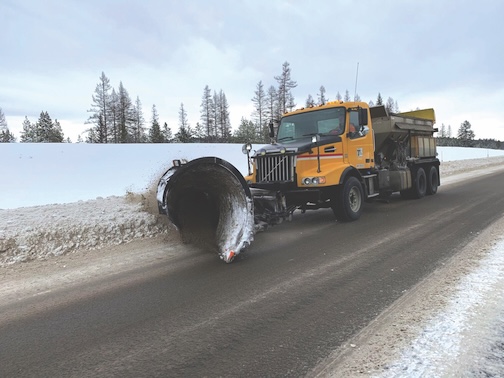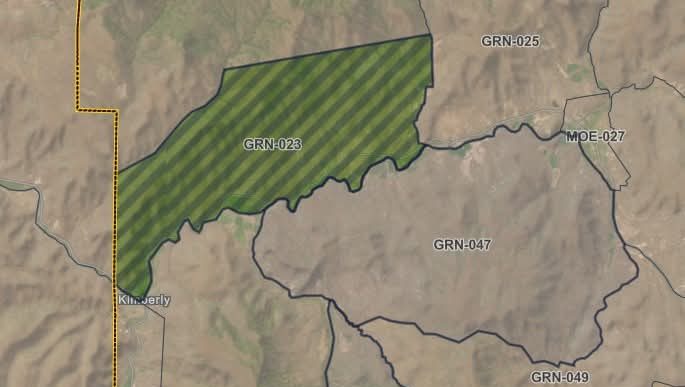CHANGING OF THE GUARD
Published 5:00 pm Tuesday, March 25, 2008

- <I>The Eagle/Scotta Callister</I><BR>Stan Benes talks to the Roadkill Chili Feed group at the John Day Senior Center.
JOHN DAY – With his tenure on the Malheur National Forest coming to an end, Supervisor Gary “Stan” Benes said last week he believes “we’ve started to turn this resource-based economy around.”
Trending
Benes spoke to about two dozen people last week at the annual Roadkill Chili Feed, a gathering organized by Dave Traylor to focus on forest and resource issues. The group met for chili and conversation at the John Day Senior Center on March 19.
In addition to Benes, Grant County Judge Mark Webb and County Commissioner Boyd Britton spoke to the group.
It was something of a farewell appearance for Benes, who has been MNF supervisor since April 2006. He and his wife are moving to Montana to be closer to family as her father copes with critical illness.
Trending
Also on hand for last week’s meeting was Cassius “Cash” Cash, who will become interim supervisor for the Malheur on April 7. Cash currently is a deputy superintentent for the Rogue River-Siskiyou National Forest, and was in town briefly to meet with Benes and other Malheur officials.
The Forest Service’s regional office expects to name a permanent successor to Benes in about a month.
Benes, who is taking a job with the Bureau of Land Management, said that in his 35 years as a resource manager, the last two years have been “the most challenging of my career.”
Amid the debate over how to manage forests, he said, he’s tried to offer straight answers to people and listen to their concerns.
Benes said the MNF harvest plan calls for 38 million board feet this year, and “we’re pretty confident we’ll get there.”
The timber harvest schedule calls for 42-43 million board feet next year, and then 50 million board feet the year after that.
While that’s nowhere near the levels of a few decades ago, it’s a trend toward sustained yield that will benefit the forest and the community, he said.
“The biggest problem right now is the market,” he said, referring to the construction industry downturn.
Benes conceded that he feels “like I’m letting some people down” by leaving now, but he stressed that there are “some very good people here” to continue the work.
He said that even though it’s better to “underpromise and overproduce” rather than give people false hope, “I feel like we’re getting a little traction here.”
“We can have a very healthy forest, we can have a sustainable industry here,” he said. “We can have our cake and eat it, too.”
As context for the current situation, he noted that the Forest Service two decades ago was seeing harvests of 240 million board feet off the Malheur.
That volume had dropped 80 percent by April 2006, when he arrived to take the supervisor’s post. The impacts on the community were varied: families were leaving, schools were losing enrollment, social problems were on the rise.
As for timber harvests, there was increasing litigation over as some idealistic people had decided that “no action was a good thing to do,” Benes said. Meanwhile, fuel levels built to dangerous levels, and the forest became increasingly fire-prone, he said.
He cited the “Save the Todd” movement that protested logging plans in portions of the Aldrich Mountains. Benes said the consequences were clear in the subsequent catastrophic fires – Shake Table two years ago, and the Egley Complex last year.
He said the Egley fire, which reached 149,000 acres, burned 20 percent of the Emigrant Ranger District.
With such fires, he said, it’s no longer just that the loggers lose. The environmentalists, recreationalists, and the communities all lose, he said.
“We finally discovered there were no winners,” he said. “Look at the Aldrich. This is a lose-lose situation.
“Nobody saved the Todd. The Todd’s running mud,” he said.
Benes said that amid some of the disputes, he felt that the green shirts of Forest Service employees “should have been black and white stripes, with whistles, because all we did was referee.”
Benes, said that during his time here, he tried to work toward active management through collaboration, bringing people with diverse views into the planning process from the start.
He noted that before his arrival, the Canyon Creek project set the stage for success with that kind of process. This year, he said, that area will see 11 million board feet harvested “between now and October.”
A collaboration on Dads Creek includes projects for 3 million board feet, and the designers include some of the people who have litigated against local timber sales in the past.
He said he believes collaboration is critical to getting people back to work on the forest.
“It’s slow. It’s messy. And no, we’re not getting back to those big old trees, but there’s a lot of stuff left in the middle,” he said.
He hopes to see projects of larger scale in the future.
“We’re not going to make a difference a thousand acres at a time,” he said.
He cited some promising developments in addition to the collaborative efforts. He said the forest has had interest from several biomass companies and a pellet plant operator, which could bode well for future harvest plans and for forest health.









